We often take it for granted that the Civil Rights Movement brought an end to segregation in American cities. But it’s often forgotten how racially divided our cities still are.
Shown below is the Racial Dot Map – one dot per person. Green represents blacks, orange represents Hispanics, blue represents whites, and red represents Asians.
As you can see, Chicago’s North Side and outer suburbs are white. Its west and south sides are black, and its northwest and southwest sides are hispanic. The borders and clear as day to see.
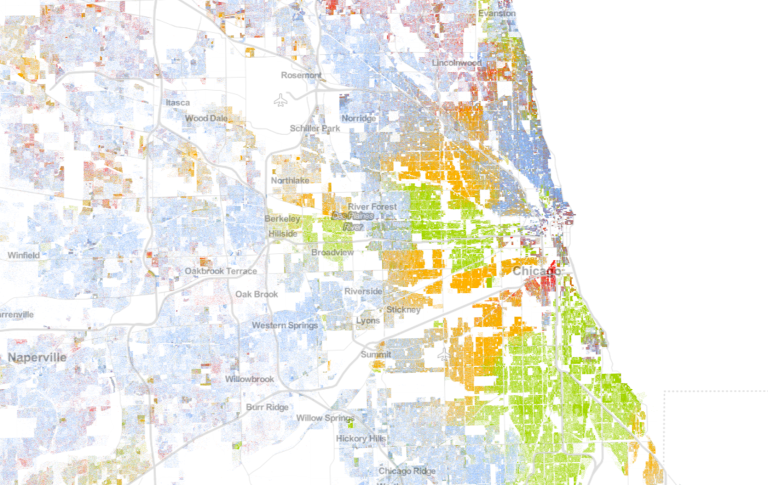
In Detroit, everything above 8 Mile Road is white, everything below is black. It’s that simple.
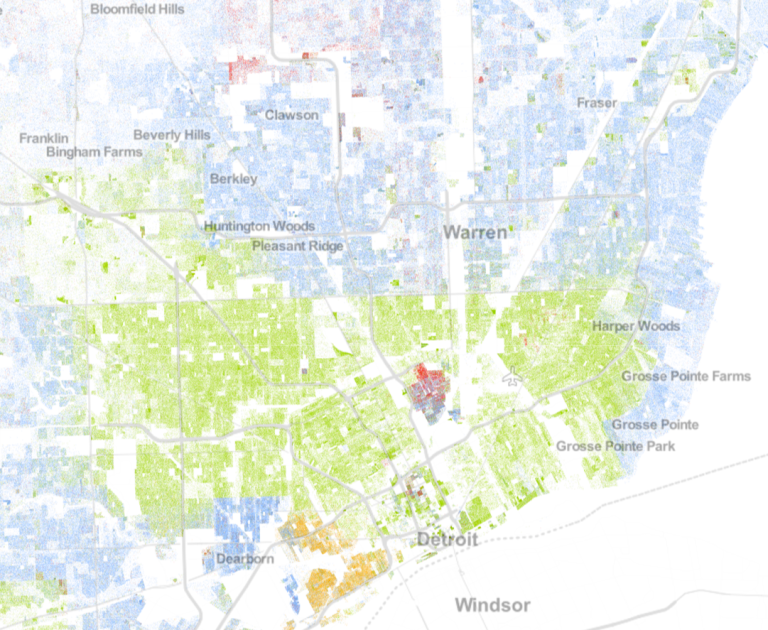
New York is subdivided at a very acute level – Hispanics in Harlem, blacks in Brooklyn, Mt. Vernon, and South Queens, and a blend of whites and Asians everywhere else.

Milwaukee‘s segregation is incredibly stark.
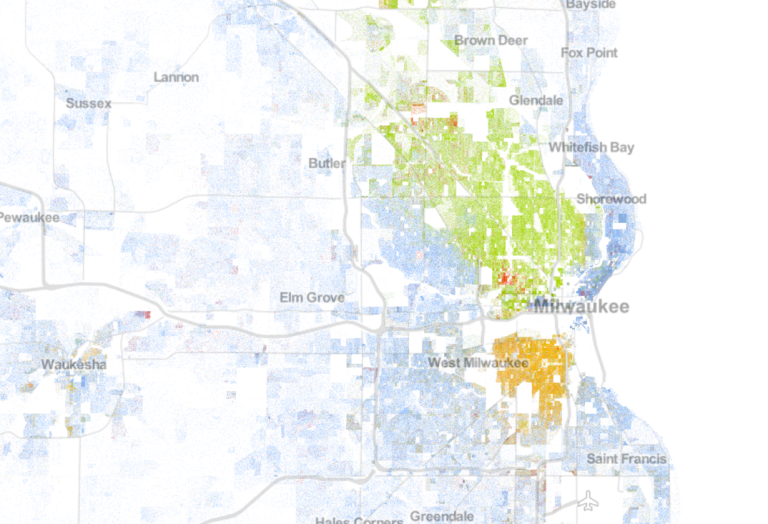
And it even occurs in small towns. Delano, California, for instance, is a Hispanic city with the west side adding blacks and the east side adding Asians.
NOTE 5/1/16: Upon further investigation, it has been found that the mixed Black/Hispanic neighborhood on the left is a jail.
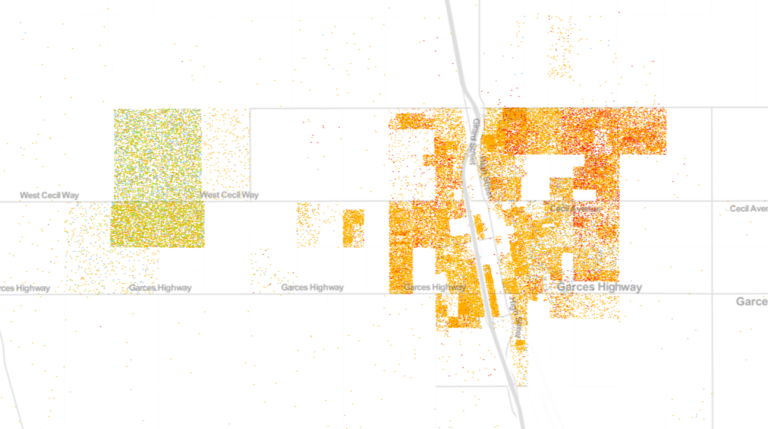
And do you see this little pocket of black people in southern Green Bay?
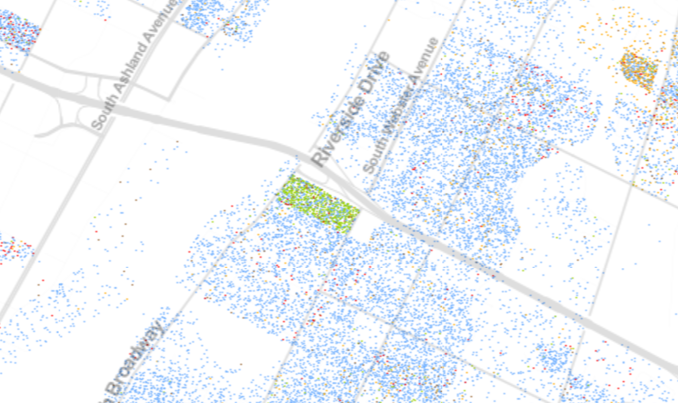
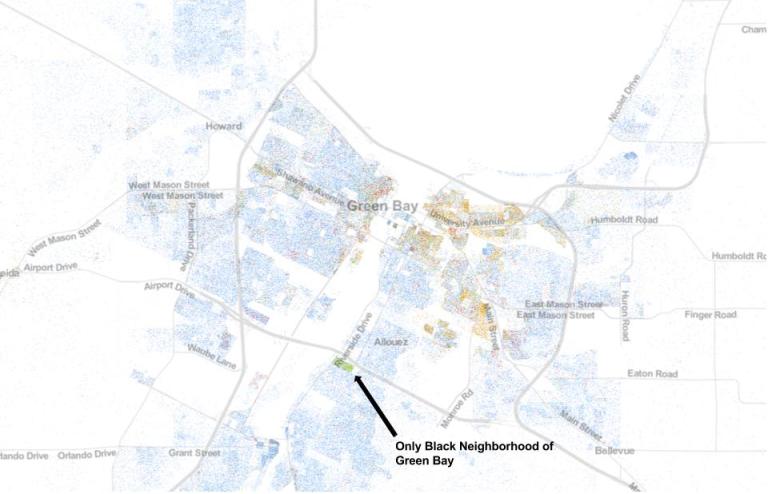
Well, I looked it up on Google Maps…
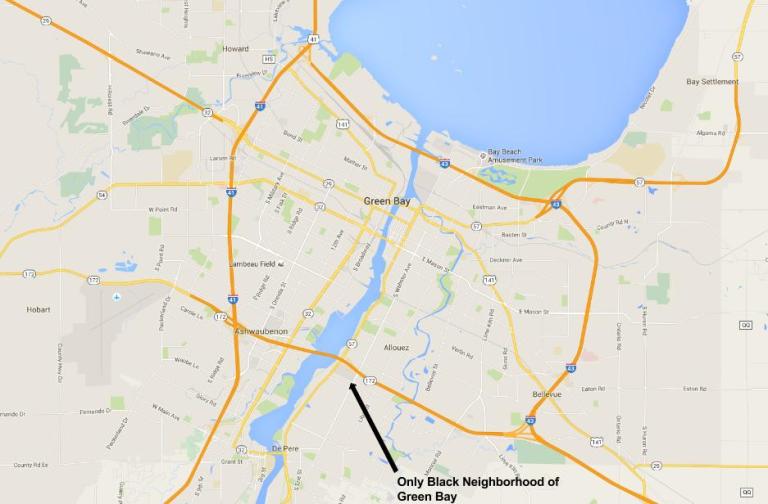
And I found that it wasn’t a neighborhood at all…
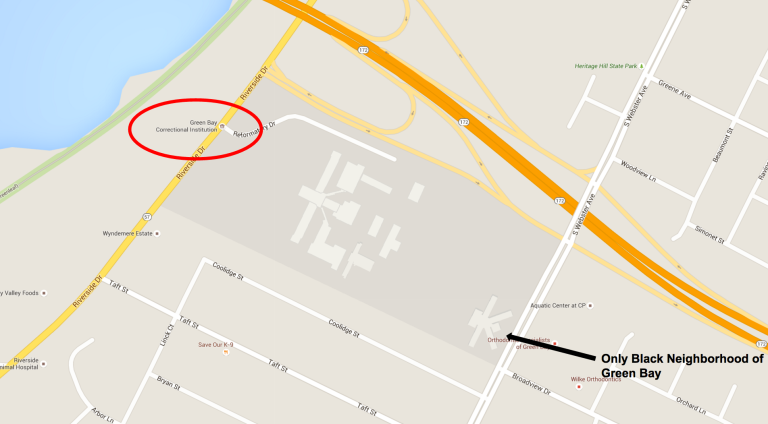
The only black neighborhood in Green Bay is “Green Bay Correctional Institution”. A jail.
That is absolutely horrendous.
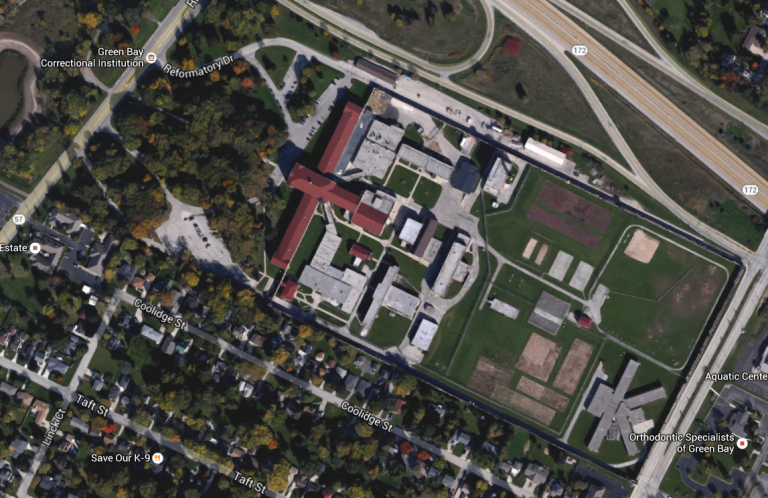
We have a racial problem all across America. It seeps into our economic systems, our educational systems, our health care systems, our police systems, and every other system imaginable. This occurs in every city in the country.
But the focus of this article is on Madison, Wisconsin, my hometown. There couldn’t possibly be more of a story to tell about the racial gap in Madison, a city with a growing black and hispanic community. While together blacks and hispanics make up only 14% of the population, the black population increased by 38% from 2000-2010, and the Hispanic population increased by 84% in the same time frame. Madison’s black and hispanic communities are growing almost 15 times faster that its white and Asian communities – and Madison’s black and hispanic communities are following the trend we saw above…they’re settling into increasingly segregated communities: The North Side, The East Side, and, most predominantly, the South Side.
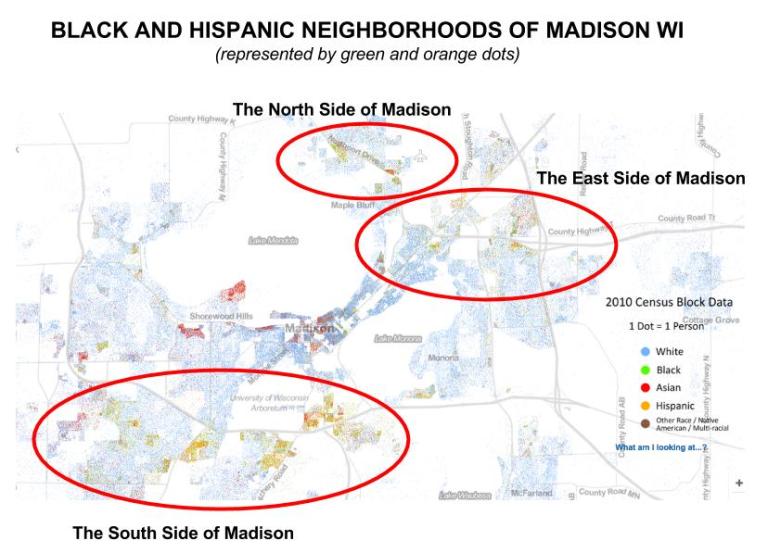
According to Business Insider and livability.com, Madison is the country’s #1 city to live in. That’s definitely true for me and most that live in the rich, white sections of Madison, where we are pampered with a thriving college campus, a plethora of high paying jobs, a growing middle class, a superior education system, and nicely paved bike paths.
But it’s often said that Madison is a city of two worlds. The world that Madison has a reputation for is the one I described above: the Utopian paradise for the affluent. But there’s a big piece missing. It’s the piece that, in my first nine years of living in a white West Side neighborhood, I never knew existed. This missing piece is the other world of Madison. It’s the Madison you don’t hear about.

When you look at Madison’s Racial Dot Map, you notice a pattern. The bottom and right sides of the map hold the majority of the black and hispanic population. It forms a curve almost – starting in the South Side, crossing along the east side of Lake Monona, and ending at the Northeast Side. I dub this curve-like chain of black and hispanic neighborhoods “The Crescent”.

Now, here’s where it gets interesting. And by interesting, I mean appalling. Shown below is a map of every single school in Madison with above average usage of free/reduced lunch programs:

That’s right. 23 out of 23 schools in Madison that have above average usage of free/reduced lunch programs all fall along the Crescent.
The deal is, the children who need free/reduced lunch are poor, obviously. So does that mean that the poorest neighborhoods of Madison fall along the Crescent? Unfortunately, that’s exactly what it means.
In Madison, a black child is 13 times more likely than a white child to be born into poverty – an insanely high disparity.
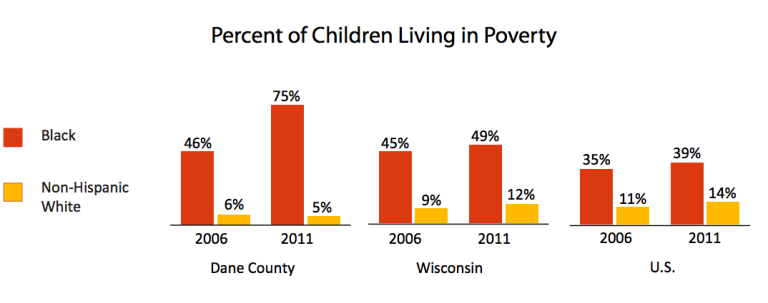
So, Madison’s black and hispanic neighborhoods (the ones on the Crescent) are its poorest neighborhoods, and Madison’s white neighborhoods (the ones not on the Crescent) are its wealthiest neighborhoods.
What are the implications of this poverty disparity? Well, to start, according to the National Center for Education Statistics and achievement gap expert James Thindwa, the number one deterrent to education is poverty. The secondmost, of course, is race. But, of course, these are not isolated phenomena – they are deeply interconnected (as the chart above shows).
So, we have poor majority of black kids who have a dual economic-and-racial barrier to education, and a rich majority of white kids who have a dual economic-and-racial advantage in education.
It’s clear, then, that schools in the Crescent of poor black/hispanic neighborhoods would be expected to have below-average academic success. And unfortunately, the map below of all Madison schools with below-average reading proficiency rates indicates that this is exactly the case.
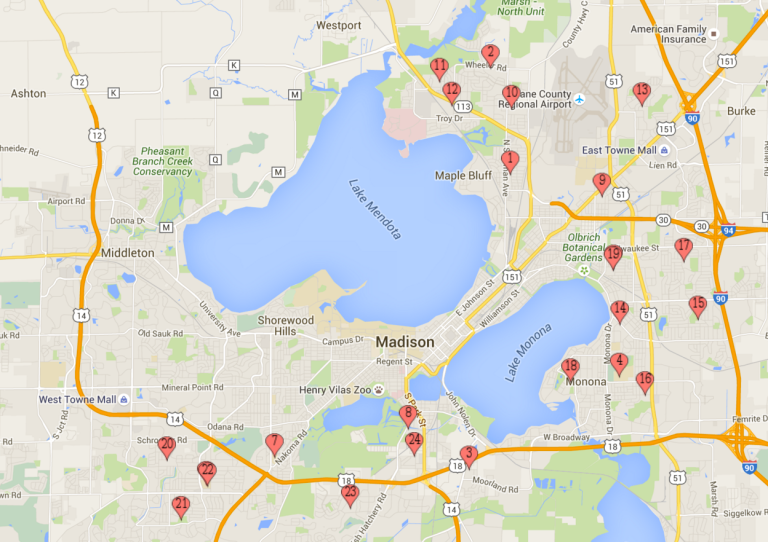
Believe it or not, 24 out of 24 schools with below-average reading proficiency rates fall along the Crescent.
The disparity in education couldn’t be more drastic. In Madison, while a solid 84% of white students graduate within four years, the reality couldn’t be any different for black students: only half, 50%, of black students graduate on time. The small percentage of black students that do take the ACT average a 36th percentile score (compared to 74th percentile scores for white students). And the percentage of black students not proficient at reading and math is almost five times higher than it is for white students.
Madison’s disparity in poverty is also directly correlated with obesity. 28% of white Madisonians are obese, but for black Madisonians the rate is a whopping 38%. This is, for a large part, a result of the fact that 17 out of 24 McDonalds, KFCs, and Burger Kings in Madison are located directly on the Crescent.
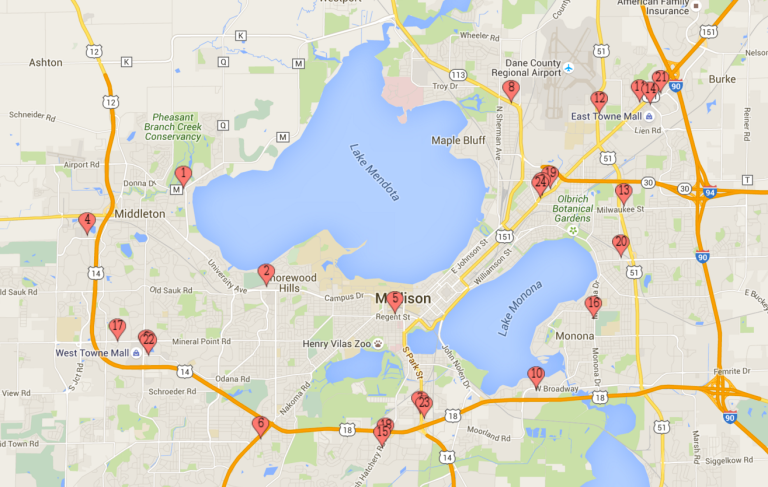
See the correlation? And this poverty disparity isn’t going to go away any time soon, either. Payday loan companies are businesses that give out loans to poor people – but the average loan has an interest rate of 570% per year, meaning that they’re hard to pay back. Payday loan companies target the poor and perpetuate the cycle of poverty — and 10 of the 12 payday loan companies in Madison are located along the Crescent, including three within three blocks on East Washington Avenue.
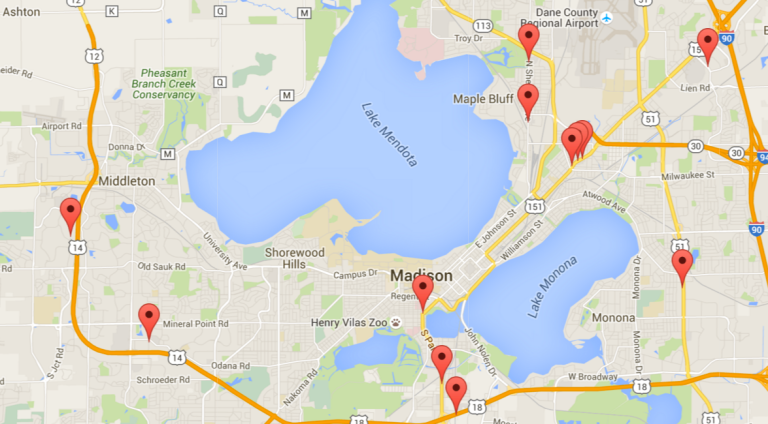
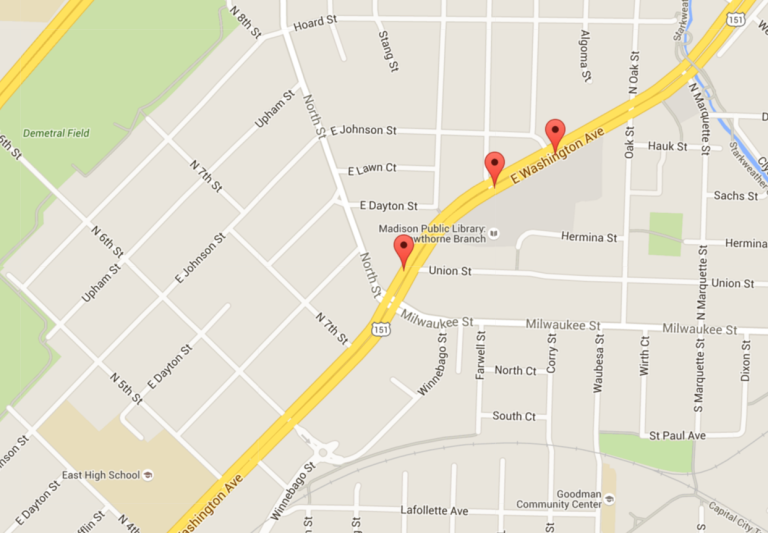
And perhaps one of the worst effects of the racial poverty disparities in Madison can be found in the Madison jails. When I worked as a protest organizer in Madison’s Black Lives Matter movement as a member of the Young Gifted and Black (YGB), I learned about YGB’s “Free the 350” campaign. The backstory was shocking: Of about 800 people in Madison’s jails, a whopping 400 (50%) of the inmates are black. Even worse, 350 of the 400 black inmates were arrested for crimes of poverty. It’s called a crime of poverty, because it means that almost 90% of Madison’s black inmates are in jail for a small crime (like public urination), and they’re still in prison simply because, with Madison’s poverty disparity, the bail is one that they just can’t pay off (while their white counterparts could). In Madison, black people are arrested at a rate 11 times higher than that of whites, even though study after study shows that blacks and whites use drugs like marijuana at roughly the same rate, as seen in the nationwide chart below.

What we see is this: a direct correlation between being black/hispanic and suffering from obesity, police injustice, educational barriers, and a cycle of poverty. All across the country, but most dramatically in Madison, a plethora of bad conditions are tied to something you can’t control – the color of your skin.
The result? In 2015, Terrell “Tony” Robinson, a black teenager in Madison, was shot by the Madison Police Department, with what I and the YGB consider an unlawful use of deadly force.

I think that YGB has it right: black and hispanic people living in these neighborhoods are not responsible for these problems. What is responsible? The racist and classist system that we live in. It’s a system that targets minorities and the poor, and has not once had the intention of doing anything but.
Black and hispanic neighborhoods need community power; they need resources, and funding, and reparations, and, most of all, action. We’ve been waiting for our government to provide these for a long time now, and it simply hasn’t happened. If our system were about to naturally fix itself, it would’ve done so by now. But it hasn’t fixed itself. What does this mean? This means that it’s wake up time. These problems won’t get solved until people begin to disrupt the system that keeps them intact. These problems won’t get solved until each and every one of us takes action to fix them.


For those interested in more, please read my newest article about Wisconsin’s incarceration disparity by clicking here.
UPDATE 7/11/17: The map below of the addresses of incarcerated Madisonians shows that incarceration in Madison tends to be clustered around the Crescent.
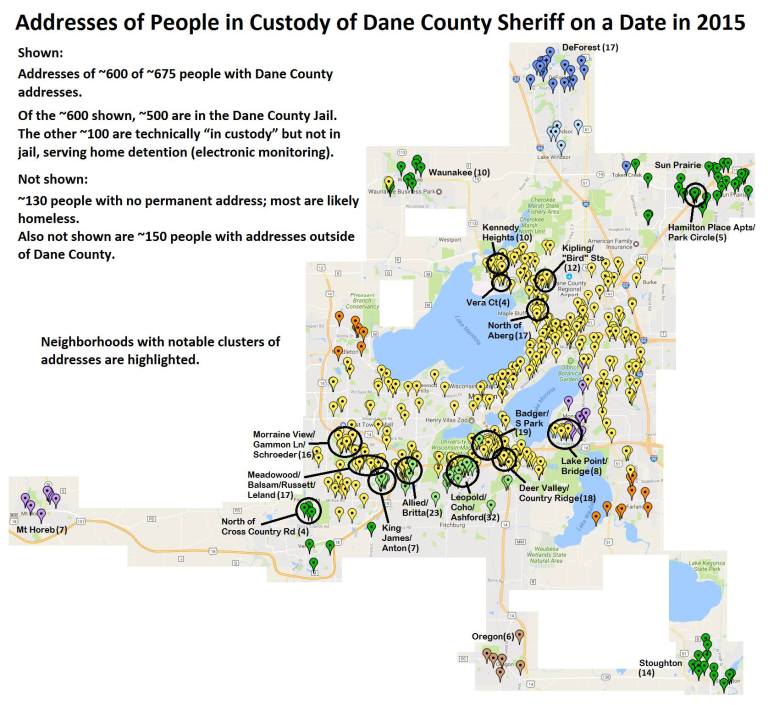

Thank you for the number crunching. I would go one step further. Things won’t change until those in power are held accountable. How long have we had the same Mayor (just one example of many)?
LikeLiked by 1 person
The grocery store map is missing several choices on the East/Southeast side. Copps near Oscar Mayer on Aberg Ave, Woodmans on Milwaukee St, Copps again at Monona Dr and the Beltline, and Super Walmart south of the Beltline at Broadway. I’m not sure how any of those got missed, as they are all rather sizeable options.
LikeLiked by 2 people
I noticed the exact same thing. Wonder how many other made up facts are in this article. Author needs to do better research and quit skewing facts.
LikeLike
Wake up and smell the dollar menu!
LikeLike
Those areas with more pwheople of other than white look harder there is more integration on the north and east sides. And where there is poverty it is all races. Damn good reason more kids living in poverty in Wisconsin and it starts with Walker and continues with his stooges in the legislature and Senate. Until they are knocked down things will only get worse. Cities won’t be able to fix the situation.
LikeLiked by 1 person
If Madison is such a terrible place for poor black people, why such a high relative population growth rate? Any ideas?
LikeLike
Wow, like what do you mean by that? Are you thinking white people should control the population of people of color by some hideous means? I just can’t think of a non-racist reason you would ask such a question.
LikeLike
I took the question to mean: why are so many black people moving here if it’s so crummy for them (higher growth rate for black/Hispanic) and not asking how do we keep Madison white. But maybe I misinterpreted what OP meant.
I think it’s a good question because there must be some advantages? So how can we build on those advantages as a community? Or how can we get out of the way/be supportive to help minorities build on those advantages?
LikeLiked by 1 person
A lot of the new arrivals may be escaping Chicago, which can be worse in many cases.
LikeLiked by 1 person
Kate,
If you can only ascribe racist reasons for my question, either you aren’t trying or you have an incredibly negative view of humanity. Or perhaps you replied quickly, with little thought.
An economist would look at this growth in a subset of population and wonder why the subset is growing (in whatever ways are being measured) relative to the population as a whole.
The author does not address, at all, how it can be that the (implied) terribleness of living in Madison for this subset can be consistent with the population of this subset growing at such a higher rate than the overall population. It’s a very interesting question and is not, at all, racist. It’s economics and sociology.
In the comments, the author comments that this could be from “escaping” Chicago. From what I’ve read, this might not be true. It could also be due to higher birth rates and it could be from people moving from Milwaukee. Doesn’t one want to know? It certainly wouldn’t take much from a sociologist or economist to analyze census data along with personal interviews to find out.
What I expect one would find out is that compared to other cities, life in Madison is actually better, not worse for this subset being analyzed in this post.
LikeLiked by 1 person
I here shit like this all of the time. Why aren’t people who live in these neighborhoods attempting to do something about it within these neighborhoods. Don’t tell me they are either, I’ve lived here all of my life and seen nothing of substance within these neighborhoods in terms of self policing etc. I have however seen tax dollars dumped into them in forms of parks, neighborhood centers etc all for nothing as security guards are beaten, drugs are sold and people actually trying to make change are harassed. I’ve witnessed it all in one shopping center on the southwest side from kids as young as 8-10 yrs old. I would think when people start attempting to do something from within they would get more support from people on the outside. Right now, however, it is just easier to blame other people for their problems. Not going to apologize for being white and working hard. There are plenty of people in this city of all races who feel the same as me (except maybe the being white part). Take responsibility for yourself. Lastly, Tony Robinsin was shot and killed by a cop because he attacked that cop. You can’t blame a police officer for reacting to a situation in a way that could potentially save his own life, he has the right to protect himself from violence when he is unsure of the assailants intentions. Did TR deserve to die? Absolutely not but he made his choice and paid the consequences. QUIT BLAMING OTHERS FOR YOUR OWN SHITTY CHOICES!!!!!!!!
LikeLike
I agree, if anyone disagrees with this opinion just go to woodmans east and observe.
LikeLike
Hey! This is really awesome and super comprehensive. Do you mind if I incorporate some of your research as take-aways as a part of an art exhibition at creative tech week? I did similar work with dot-density mapping and projected it onto a 3-d printed terrain map. We seem to have similar thoughts on the subject.
LikeLike
Correlation =/= Causation, and vice versa. What exactly is this trying to purport? All I see is a bunch of hand-picked “statistics” that do nothing but point out that people of similar culture (read: race) generally live together rather than with other cultures that are less similar. It doesn’t take a genius to figure that out, just look at the concept of countries. It has much less to do with skin color as it has to do with the predominant culture of those folks. Just the fact that we say that a black person is “acting white” tells you that it is not some instinctual behavior but rather something that is learned or adopted. Yes physical differentiation exists, but we as humans have a way of choosing how we act. The choice to take a risky PayDay loan is made not because one is Hispanic or black, but rather because one feels so in need that it seems like a good idea, or they legitimately do not know how harmful it is. All this “article” does is show certain qualities that are determined by choice, not race. You can paint it with whatever brush you’d like, but the fact is in the African American community, there are much higher levels of births out of wedlock, fewer complete family units, greater acceptance or drugs, the list goes on. None of those issues are purely because one is Black. I suggest you take a good look at the writings of Dr. Martin Luther King, see how one actually recognizes injustice, and acts upon that, rather than destroying cities and then complaining injustice against oneself.
LikeLike
Correlation says an awful lot. It’s not only race, as I made very clear. It’s also poverty. It would be hard to argue that taking out a risky loan and fast food consumption, for example, as well as educational barriers, are not in any way “causated” by poverty (which is, as I explain, racialized poverty). Payday loans, for example, are purely economic decisions.
LikeLike
I’d venture a guess that it’s mostly poverty (which is likely partially caused by race). The further you go downtown, the more insane rent gets. The poor (who are more likely to be non-white) live on the outskirts since they can’t afford to live downtown, which is why you see a mix of all races and not just minorities on the “crescent”
LikeLike
I think the point is, that people use payday loans because other means, such as traditional banks are not accessible. If you receive lesser education, you earn less, and if you earn less traditional bank credit is not as available. This is how racism becomes systematic.
For generations, POC were legally limited to living in certain areas, now many are economically held to those same areas.
Further, drug use rates are similar across race, but arrest and incarceration rates couldn’t be different.
These are injustice, we need to recognize them, and we need to act. To not act, or to deny the injustice is what created these problems.
LikeLiked by 1 person
Beautifully said!!! I completely agree. It’s very much about poverty, but it’s also very much about race!
LikeLike
what is the name of the author of this blog?
LikeLike
My name is Lew Blank
LikeLike
Mr. Blank,
I’m glad you drew attention to the racial disparities in our city, but I wish you would focus on the class disparities in greater detail. While it is true that a significant portion of the wage classes are people of color, it should be noted that there are also a fair portion who are white. Poverty is color blind. If we wish an inclusive program to resolve the problem, it may be wiser to create blanket programs that help people who are just poor rather than people who are poor and of a certain ethnic background. Wage earners across ethnic backgrounds are struggling, and could use our support.
Second, you may want to take a second look at the “food desert” problem. Madison has a good distribution of supermarkets. There is only one area, along Rimrock rd., that doesn’t have a accessible market. HOWEVER, it is true that access to reasonably priced food is missing in certain areas of the city. Several markets close to poorer neighborhoods are high-end, that is serving middle and upper-middle class cliental, grocers. For the sake of accuracy could you edit the article to reflect that?
Regards,
Varun Bhaskar
Editor
View on the Ground
LikeLike
Varun – yes poverty is colorblind…except for when a black child in Madison is 13 times more likely to be in poverty that a white child.
LikeLiked by 1 person
The tl;dr of this article:
* Race is highly correlated with poverty (in USA)
* Poverty is highly correlated with the neighborhood where one lives
* Poverty is highly correlated with criminal behavior and (negatively) with educational attainment.
None of these is newsworthy.
What is newsworthy is that some people continue to divide ratios by other ratios and think that has any meaning. Sigh.
I’ll offer up one suggestion. Let’s focus on poverty, not skin color.
LikeLike
A lot of the commenters on this article indicate that they believe class/poverty overall to be the problem worth discussing rather than race. The thing that is important to recognize is that poverty in America today and where certain groups of people live is a product of systemic oppression and racism in society. Redlining and other practices clearly have left a lasting impact on Madison (and many other cities). Yes, people of similar cultures often times like to live nearby for social support. But in this day and age, that concept is no longer responsible for the extremes in segregation of neighborhoods (although some Hispanic/Latino communities are formed for support due to easier access to jobs for those undocumented, or specific Asian groups like the Hmong that when initially coming to the US were more successful/felt more supported among a community of their own). What is really responsible, however, is the long term effects of institutionalized racism and things like lack of affordable housing (which in a city like Madison with something like a 2-3% rental vacancy rate, clearly is a problem) and food deserts. In addition, it is important to note that the educational disparities among races are drastic in Dane County in general and this can be attributed to lack of culturally relevant teaching (dominant culture curriculum, minorities underrepresented in school staff/admin, and poverty in general etc…). I definitely think the author is spot on when he states that the disparities are not only along class lines, but also inherently racial.
LikeLiked by 2 people
ELLEN THANK YOU!!!! YOU are spot on!!!!
LikeLike
Lew, good work on this article. For those reader who need to see research collected and analyzed by sociologists and poverty experts, check out the UW’s Institute for Research on poverty – I recommend reading through the FAQ section. There is substantial research that coorborates exactly what Lew lays out here. Sure there are poor white people, but think about this for a second: 75% of black children compared to 5% of white children are in poverty – poverty is impacting black families at an overwhelming rate & thats no coincidence. This segregation isn’t happening because of different cultures separating themselves – in fact we have a long history of segregation and racist housing policies in this country and we haven’t come close to fixing that. If you don’t believe us do some research on red-lining, read Ta-Nehisi Coates’s infamous article on reparations, but do NOT dismiss this as not a racialized problem or as existing because blacks don’t work hard enough.
LikeLike
Lew,
Great work! We are circulating and will be using this!
Madison ISO
LikeLike
Wonderful, thanks ISO!
LikeLike
Well I was trying to respond to intital thread that I started, but for some reason there’s no reply button available. Bloody technology, anyway.
I agree with you that black children are 13 times more likely to end up in poverty than white. It seems to me when a boat is sinking and x number of people are below the water line, bickering about the particularities of the color of their skin or the historical circumstances of their condition is less important than helping all of them. Yes, black children are more likely to be born into poor families, but so what? Even one child of any skin color living in poverty is too much. Are you suggesting we allocate more resources to help one community of poor over the other? If so, do you really expect to garner public support for that proposal?
Regards,
Varun Bhaskar
Editor
View on the Ground
LikeLike
Varun – this is a legitimate point. Here’s what I think in regards to Affirmative Action.
I’ve always believed that the number one goal of AA should be to help kids in poverty. The question is, should it just be kids of color, or all kids.
Let me present a scenario. Let’s say there are 1,000 poor white kids and 1,000 poor black kids. You can only give social benefits / escape from poverty to 1,000 kids. Do you do 500 each, or do you pick the 1,000 poor black kids.
In my opinion, while they are BOTH good options, I’d choose the latter – the first option closes the poverty gap, the second option closes the poverty gap AND the racial gap. That’s two for the price of one.
But I think we agree that the optimal solution would be to get all 2,000 kids on these programs.
We also agree that closing the class privilege gap is the best part of AA, regardless of race.
That’s just my opinion, thanks for sharing yours.
LikeLike
The method you suggest may reduce both race and wealth gap, but it will do so at the cost of social stability. I’m from a country where your suggested method was tried, and the result was cast riots. Replace the word caste with race and what you have is similar circumstances in the US under a different name. Telling a group of poor people (which I will refer to as group A) that you will be focusing the entirety of a very finite resource base to help a group of slightly different poor people (group B), is a recipe for animosity and violence. How do you think Group A will react if you go to them and say they will receive no help because they are privileged?
I must agree with Jim, focusing on poverty as a whole is a far wiser choice. That would allow all classes, across races (or castes if you prefer), to maintain unity in the face of rising adversity. To do anything else would open up the social programs to attack by the worst kind of racist demagogues.
LikeLike
That is an interesting perspective. I would like to bring up that if we choose not to address racial disparities, that will cause animosity and protesting too.
LikeLike
“That is an interesting perspective. I would like to bring up that if we choose not to address racial disparities, that will cause animosity and protesting too.”
That, I would argue, is the beauty of focusing on poverty over the racial divide. You resolve part of the problem of the racial divide, part of the problem of poverty, and part of the problem of social unity. To use your earlier example, if we use our finite resource base to help 500 from Group A and 500 from Group B, then we have proof of intent. People are far more lenient toward those who demonstrate some good will, than none at all. Is it fair? Probably not totally, but given the bad place the country is in I would argue it’s the best we can probably hope for.
LikeLike
I think we need to realize that this group A/B scenario doesn’t totally work for this situation. When we consider that the population of those in poverty are disproportionately black and Latino then our numbers would change. Let’s say group A are black people and group B are white people. There are 1500 people in group A and 500 people in group B… You can help 1,000. What would you do? Help 750 from group A and 250 from group B, aka 50% from both group? If you agree with this principle then that illustrates what affirmative action is. It is ensuring that minorities have a helping hand. It also emphasizes the point that this is very much a racially driven system which is exactly what the author stated in the article.
LikeLike
I’d just like to respond to View on the Ground. I understand where you are coming from but what I think the author might be getting at is that the history of the injustices caused by race is systemic. You can’t just erase that and focus on social class because that would be equality but not equity. What is equitable is accounting for white privilege and history’s impact on the present. That means that white people in poverty are able to overcome their challenges and rise up in social class relatively easier than a poor person of color. That doesn’t mean that those white people in poverty don’t face very difficult circumstances, but that does mean that because of the systemic racism that is so ingrained into our society, subtle preferences are given to whites (usually due to a subconscious bias). Therefore I think it is important to account for race and not just class.
Lastly I’d also like to respond to Jim. You make valid points in that it is always important to continue researching a topic to better support an argument (as well as always being open to whether or not you are factually correct). But I disagree with you in that you can not just focus in on one issue without considering the great impact that the intersectionality of one’s identities has on that issue. You can’t just look at poverty and not also discuss the other parts of people’s identities that directly correlate to social class such as racial, ethnic, cultural, and gender identities. Therefore I think that it is imperative to continue the conversation on poverty AND race as I find it very relevant to our society today.
LikeLiked by 1 person
Thanks for getting this article to 59 countries! We have nearly 10,000 views on this article and nearly 11,000 on the website as a whole!
Couldn’t be more honored.
LikeLiked by 1 person
They need to burn down that racist capital, and all its kkk members running that city, and the lawyers that work for the racist system.
Madison is the most racist city systems i know about.
LikeLike
Lew,
I would be interested in seeing a map of rental housing coded by cost. Would that correlate with poverty or skin color?
LikeLike
Thanks for your comment. Here is a map of household income in Madison (not rental prices, just median housing income): http://www.city-data.com/nbmaps/neigh-Madison-Wisconsin.html. It appears that the lighter areas (poorer areas) correlate with the Crescent.
LikeLike
Hello Lew,
I’m familiar with your work for Atlas Obscura and Outsider News. The argument presented in this article is very compelling, as are the statistics you use. I’m filming a documentary involving Justified Anger and modern-day segregation in Wisconsin. Would you be willing to be interviewed for this documentary, and provide your input on Madison’s role in systematic racism?
Please let me know by email if you’d like more information.
LikeLike
Hi there Lew,
Your article is partially responsible for writing an article on Madison’s segregation, dress codes on State Street, and outlawing hip-hop. Thanks for writing this. I hope you don’t mind that I used your Crescent map and credited you for it. If you are so inclined, here is my article called State Street Mask Off: https://fueledbyjames.wordpress.com/2017/07/07/state-street-mask-off/
Sincerely,
James Marshall
LikeLike
Really excellent article!
-Lew
LikeLike
It’s been over four years since you published this, and it’s more true than ever. Thank you for this.
LikeLike